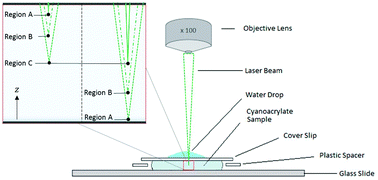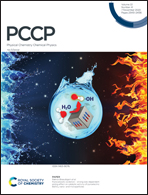Use of confocal Raman microscopy to characterise ethyl cyanoacrylate adhesive depth curing
Abstract
In situ spatial temporal measurement of monomer conversion during adhesive bondline curing remains a challenging area. The aim of this work was to demonstrate the effectiveness of using confocal Raman microscopy in a specially configured experimental set-up, as a versatile tool for measuring monomer concentration changes as a function of both time and adhesive bond depth during ethyl cyanoacrylate polymerisation. This also allowed monitoring of the extent of polymerisation at the adhesive substrate interface independently of the bulk bondline polymerisation region. Key kinetic parameters such as inhibition time tlag, rate of reaction Rmax and extent of reaction [αt]max were obtained by fitting the experimental data to sigmoidal growth curves using simple piecewise regression models. A systematic characterisation of a polymerisation reaction was conducted using different sample substrate types (copper alloy (red brass), aluminium, aluminium alloy, stainless steel and borosilicate glass) and at various reaction temperatures. Reaction rates were found to decrease further away from the substrate interface in the bulk volume region. The fastest kinetics occurred in the vicinity of nucleophilic hydroxyl rich surfaces such as at the copper alloy (red brass). In addition to substrate surface chemistry, surface roughness was also a factor, with the highest reaction rates occurring with a grit blasted (roughened) aluminium alloy (2024 T3) surface. An approximately linear dependence of the ln Rmaxvs. 1/T (Arrhenius) plot was recorded within the temperature range of 291–328 K. A better fit was obtained however through the use of two separate linear slopes, possibly indicative of a change of polymerisation reaction mechanism taking place at elevated temperatures with two distinct activation energies. Further work conducted using a larger number of temperatures would be useful to verify this finding. This work confirmed that differences in the rates of interfacial and bulk polymerisation processes could be readily measured in situ using confocal Raman microscopy which is a powerful technique for investigating such surface-confined and bulk polymerisation reactions.



 Please wait while we load your content...
Please wait while we load your content...